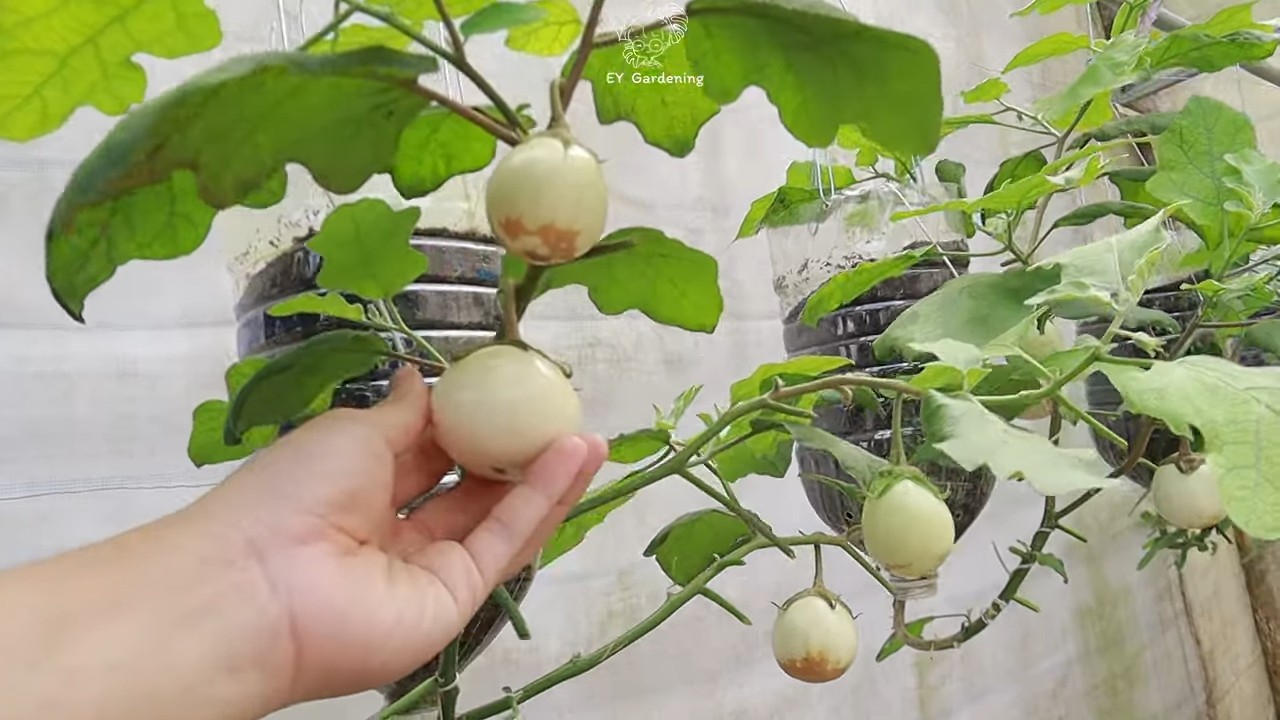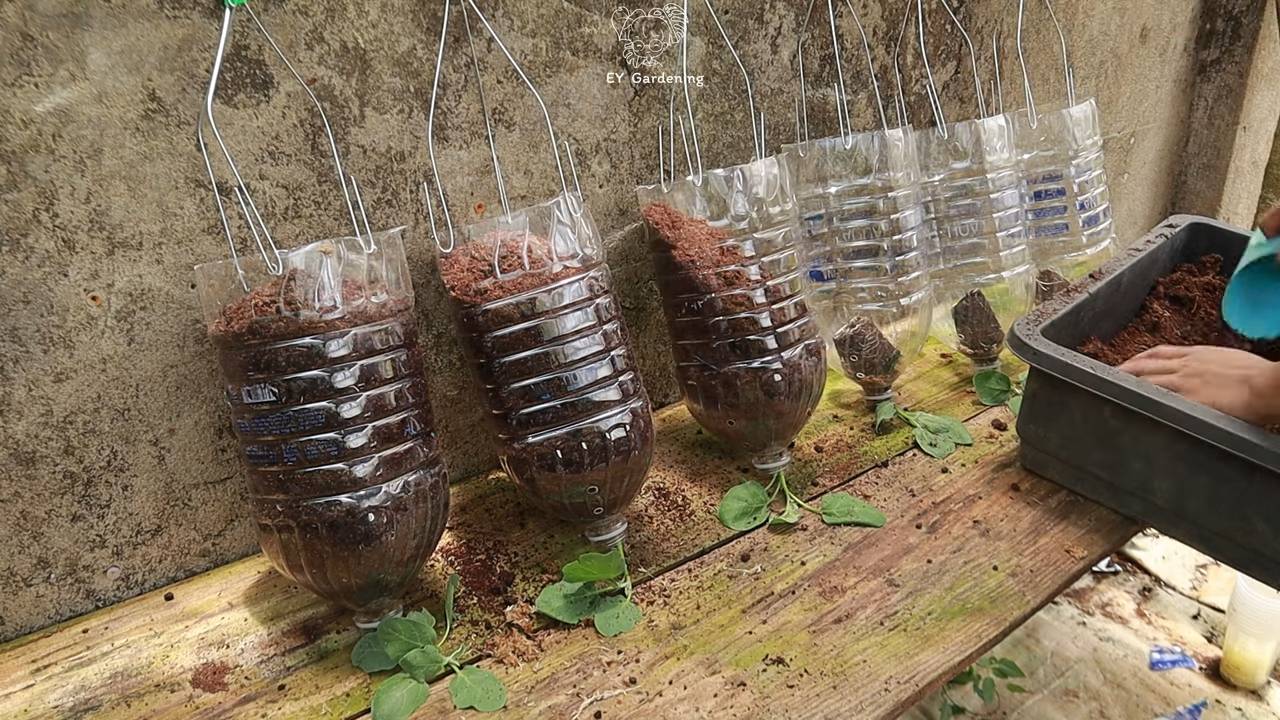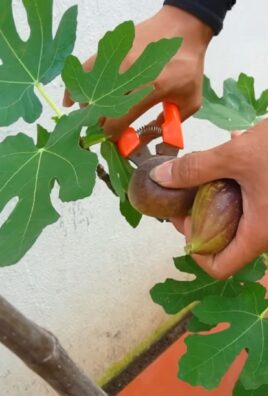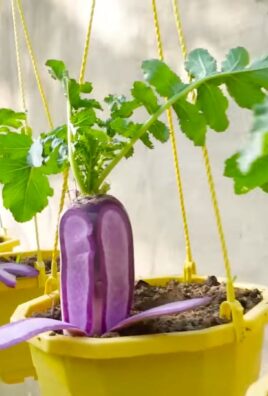Hanging Eggplant Growing Tips: Imagine plucking plump, glossy eggplants right from a hanging basket on your patio! Sounds like something out of a fairytale, right? Well, it doesn’t have to be! For centuries, gardeners have been experimenting with innovative ways to cultivate their favorite vegetables, and hanging gardens, while often associated with ancient wonders, are making a serious comeback in the modern home gardening scene.
But why should you consider growing eggplants in hanging baskets? Well, for starters, it’s a fantastic space-saver, especially if you’re working with a small balcony or limited yard space. Plus, hanging eggplants are less susceptible to soil-borne diseases and pests, keeping your precious plants healthier and happier. Let’s be honest, who wants to spend their weekends battling bugs instead of enjoying the fruits (or vegetables!) of their labor?
In this DIY guide, I’m going to share my tried-and-true hanging eggplant growing tips and tricks to help you create your own stunning and productive hanging garden. From choosing the right eggplant variety to crafting the perfect hanging basket setup, I’ll walk you through every step of the process. Get ready to impress your neighbors and enjoy a bountiful harvest of delicious, homegrown eggplants!

Hanging Eggplant: A DIY Guide to Vertical Gardening Success
Hey there, fellow gardening enthusiasts! I’m so excited to share my experience with growing eggplants in hanging baskets. It’s a fantastic way to maximize space, deter pests, and add a touch of whimsy to your garden or balcony. Trust me, once you see those beautiful purple fruits dangling down, you’ll be hooked!
This guide will walk you through everything you need to know to successfully grow eggplants in hanging baskets, from choosing the right variety to harvesting your delicious bounty. Let’s get started!
Choosing the Right Eggplant Variety
Not all eggplants are created equal, especially when it comes to hanging baskets. You’ll want to select a variety that’s compact and produces smaller fruits. This will prevent the plant from becoming too heavy and unwieldy for your hanging basket. Here are a few of my favorite varieties for container gardening:
* Fairy Tale: These eggplants are small, striped, and incredibly productive. They’re perfect for smaller baskets and have a mild, sweet flavor.
* Hansel: Similar to Fairy Tale, Hansel eggplants are compact and produce clusters of small, dark purple fruits.
* Patio Baby: As the name suggests, this variety is specifically bred for containers. It produces small, glossy black eggplants that are perfect for grilling or roasting.
* Little Fingers: These long, slender eggplants are easy to grow and have a delicate flavor. They’re a great choice if you’re looking for something a little different.
* Thai Green: These small, round, green eggplants are perfect for Asian-inspired dishes. They’re also relatively compact and well-suited for hanging baskets.
Gathering Your Supplies
Before you start planting, you’ll need to gather all the necessary supplies. Here’s a checklist to make sure you have everything you need:
* Hanging Basket: Choose a basket that’s at least 12 inches in diameter and 10 inches deep. The bigger, the better, as eggplants need plenty of room for their roots to grow. Make sure it has good drainage holes.
* Potting Mix: Use a high-quality potting mix that’s specifically formulated for containers. Avoid using garden soil, as it can become compacted and doesn’t drain well. I prefer a mix that contains peat moss, perlite, and vermiculite.
* Eggplant Seedlings: You can start your eggplants from seed, but I find it easier to purchase seedlings from a local nursery. Look for healthy plants with sturdy stems and no signs of pests or diseases.
* Slow-Release Fertilizer: Eggplants are heavy feeders, so you’ll need to provide them with a steady supply of nutrients. A slow-release fertilizer will gradually release nutrients over several months.
* Watering Can or Hose: You’ll need a way to water your eggplants regularly. A watering can with a gentle rose head is ideal for preventing soil erosion.
* Pruning Shears or Scissors: You’ll need these to prune your eggplants and remove any dead or damaged leaves.
* Gloves: Gardening gloves will protect your hands from dirt and thorns.
* Optional:
* Coco Coir Liner: If your hanging basket doesn’t have a liner, you can use a coco coir liner to help retain moisture.
* Water-Retaining Polymer Crystals: These crystals can be added to the potting mix to help retain moisture and reduce the frequency of watering.
* Plant Support: Depending on the variety you choose, you may need to provide some support for your eggplant plants as they grow.
Planting Your Eggplant
Now for the fun part! Here’s how to plant your eggplant in a hanging basket:
1. Prepare the Basket: If your basket doesn’t have a liner, line it with coco coir or landscape fabric. This will help prevent the soil from drying out too quickly.
2. Fill the Basket with Potting Mix: Fill the basket about two-thirds full with potting mix.
3. Add Slow-Release Fertilizer: Sprinkle a generous amount of slow-release fertilizer over the potting mix, following the instructions on the package.
4. Create a Planting Hole: Dig a hole in the center of the basket that’s large enough to accommodate the root ball of your eggplant seedling.
5. Remove the Seedling from its Container: Gently squeeze the sides of the container to loosen the root ball. Carefully remove the seedling from the container, being careful not to damage the roots.
6. Plant the Seedling: Place the seedling in the planting hole and gently spread out the roots. Make sure the top of the root ball is level with the surface of the potting mix.
7. Fill in with Potting Mix: Fill in the remaining space around the seedling with potting mix, gently firming the soil around the base of the plant.
8. Water Thoroughly: Water the eggplant thoroughly until water drains out of the bottom of the basket. This will help settle the soil and ensure that the roots are well-hydrated.
Caring for Your Hanging Eggplant
Once your eggplant is planted, it’s important to provide it with the proper care to ensure healthy growth and abundant fruit production. Here’s what you need to do:
1. Watering: Eggplants need consistent moisture, especially when they’re growing in containers. Water your eggplant regularly, especially during hot, dry weather. Check the soil moisture by sticking your finger into the soil. If the top inch of soil feels dry, it’s time to water. Avoid overwatering, as this can lead to root rot.
2. Sunlight: Eggplants need at least 6-8 hours of sunlight per day to thrive. Place your hanging basket in a sunny location where it will receive plenty of direct sunlight.
3. Fertilizing: In addition to the slow-release fertilizer you added at planting time, you may need to supplement with liquid fertilizer every few weeks. Use a balanced fertilizer that’s specifically formulated for vegetables. Follow the instructions on the package.
4. Pruning: Pruning your eggplant can help improve air circulation and encourage fruit production. Remove any dead or damaged leaves, as well as any suckers that grow from the base of the plant. You can also prune the tips of the branches to encourage bushier growth.
5. Pest and Disease Control: Eggplants are susceptible to a variety of pests and diseases, including aphids, flea beetles, and spider mites. Inspect your plants regularly for signs of infestation or disease. If you notice any problems, take action immediately. You can use insecticidal soap or neem oil to control pests. For diseases, you may need to use a fungicide.
6. Support: As your eggplant grows, it may need some support to prevent the branches from breaking under the weight of the fruit. You can use plant stakes or tomato cages to provide support.
7. Pollination: Eggplants are self-pollinating, but they may need some help from you to ensure good fruit set. Gently shake the plant or use a small paintbrush to transfer pollen from one flower to another.
Harvesting Your Eggplant
The moment you’ve been waiting for! Harvesting your eggplants is the most rewarding part of the process. Here’s how to do it:
1. Check for Ripeness: Eggplants are typically ready to harvest when they’re about two-thirds of their mature size and have a glossy, vibrant color. The skin should be firm and slightly resistant to pressure.
2. Cut the Stem: Use a sharp knife or pruning shears to cut the stem of the eggplant about an inch above the fruit. Be careful not to damage the plant.
3. Enjoy Your Harvest: Eggplants are best eaten fresh, but they can also be stored in the refrigerator for up to a week. Use them in your favorite recipes, such as eggplant parmesan, ratatouille, or baba ghanoush.
Troubleshooting
Even with the best care, you may encounter some problems when growing eggplants in hanging baskets. Here are a few common issues and how to address them:
* Yellowing Leaves: Yellowing leaves can be a sign of overwatering, underwatering, or nutrient deficiency. Check the soil moisture and adjust your watering schedule accordingly. If the soil is dry, water thoroughly. If the soil is soggy, allow it to dry out before watering again. You may also need to fertilize your eggplant with a balanced fertilizer.
* Blossom End Rot: Blossom end rot is a condition that causes the bottom of the eggplant to rot. It’s usually caused by calcium deficiency. To prevent blossom end rot, make sure your soil is well-drained and that you’re providing your eggplant with adequate calcium. You can add lime to the soil or use a calcium-rich fertilizer.
* Pests: As mentioned earlier, eggplants are susceptible to a variety of pests. Inspect your plants regularly for signs of infestation and take action

Conclusion
So, there you have it! Transforming your eggplant cultivation with these hanging eggplant growing tips isn’t just a quirky gardening experiment; it’s a game-changer that can lead to healthier plants, bigger yields, and a visually stunning garden. We’ve explored how this method combats common eggplant ailments, maximizes space, and even adds a touch of elegance to your outdoor (or indoor!) growing area.
Think about it: no more battling soil-borne pests crawling up your precious plants, no more wasted space in your garden beds, and a unique conversation starter for all your gardening friends. The benefits are truly compelling.
But don’t just take our word for it. The real magic happens when you put these hanging eggplant growing tips into practice. Experiment with different container sizes to find what works best for your eggplant variety. Try using a soilless potting mix for optimal drainage and aeration. Consider adding companion plants like marigolds or basil to your hanging baskets to further deter pests and attract beneficial insects.
For those in cooler climates, this method offers an excellent opportunity to extend your growing season. Simply bring your hanging eggplant indoors during colder months and enjoy fresh eggplant even when the weather outside is frightful. You can even use grow lights to supplement natural sunlight and ensure your plants continue to thrive.
And for the adventurous gardeners out there, why not try grafting your eggplant onto a more vigorous rootstock before hanging? This can further enhance disease resistance and yield potential. The possibilities are endless!
We understand that trying something new can be daunting, but we’re confident that with a little preparation and these easy-to-follow tips, you’ll be amazed at the results. Imagine the satisfaction of harvesting plump, juicy eggplants from your own hanging garden, knowing that you’ve created a thriving ecosystem with your own two hands.
So, what are you waiting for? Gather your supplies, choose your favorite eggplant variety, and embark on this exciting gardening adventure. We encourage you to document your progress, share your successes (and even your challenges!), and connect with fellow gardeners who are also exploring the wonders of hanging eggplant growing.
Share your photos and stories on social media using relevant gardening hashtags. Let’s create a community of hanging eggplant enthusiasts and inspire others to embrace this innovative growing technique.
Remember, gardening is a journey, not a destination. There will be ups and downs, but the rewards of growing your own food, especially with these hanging eggplant growing tips, are immeasurable. Happy gardening!
Frequently Asked Questions (FAQ)
What are the best eggplant varieties for hanging baskets?
Smaller, more compact eggplant varieties tend to perform best in hanging baskets. Look for varieties like ‘Fairy Tale,’ ‘Hansel,’ ‘Gretel,’ or ‘Patio Baby.’ These varieties are bred to be more manageable in containers and produce smaller, more manageable fruits. However, with proper support, you can also try larger varieties, just be mindful of the weight and stability of your hanging basket. Consider the mature size of the plant and the size of the fruit when making your selection. Dwarf varieties are often the easiest to manage.
What type of container is best for hanging eggplant?
Choose a container that is at least 12 inches in diameter and 12 inches deep to provide adequate space for the eggplant’s root system. Hanging baskets made of plastic, metal, or even repurposed materials like old tires can work well. Ensure the container has good drainage holes to prevent waterlogging, which can lead to root rot. Consider using a self-watering hanging basket to help maintain consistent moisture levels, especially during hot weather. The material of the container can also affect soil temperature, so choose a material that is appropriate for your climate.
What kind of soil should I use for hanging eggplant?
Use a well-draining potting mix specifically formulated for containers. Avoid using garden soil, as it can become compacted and impede drainage. A mix of peat moss, perlite, and vermiculite is a good option. You can also add compost to the mix to provide additional nutrients. Consider adding a slow-release fertilizer to the potting mix at planting time to provide a steady supply of nutrients throughout the growing season. The ideal pH for eggplant is between 6.0 and 6.8.
How often should I water my hanging eggplant?
Water your hanging eggplant regularly, especially during hot, dry weather. Check the soil moisture daily and water when the top inch of soil feels dry to the touch. Avoid overwatering, as this can lead to root rot. Hanging baskets tend to dry out more quickly than plants in the ground, so be prepared to water more frequently. Consider using a watering can with a long spout to reach the soil without wetting the foliage, which can help prevent fungal diseases.
How much sunlight does hanging eggplant need?
Eggplant requires at least 6-8 hours of direct sunlight per day to thrive. Choose a location for your hanging basket that receives plenty of sunlight. If you live in a hot climate, provide some afternoon shade to prevent the plants from overheating. If you are growing your eggplant indoors, use grow lights to supplement natural sunlight. Rotate the hanging basket regularly to ensure that all sides of the plant receive adequate sunlight.
How do I fertilize my hanging eggplant?
Fertilize your hanging eggplant every 2-3 weeks with a balanced liquid fertilizer. Look for a fertilizer that is specifically formulated for vegetables. Follow the instructions on the fertilizer label carefully. You can also use a slow-release fertilizer at planting time to provide a steady supply of nutrients throughout the growing season. Avoid over-fertilizing, as this can lead to excessive foliage growth and reduced fruit production.
How do I protect my hanging eggplant from pests and diseases?
Inspect your hanging eggplant regularly for pests and diseases. Common eggplant pests include aphids, flea beetles, and spider mites. Treat infestations promptly with insecticidal soap or neem oil. To prevent fungal diseases, ensure good air circulation around the plants and avoid overhead watering. Remove any diseased leaves promptly. Consider using companion plants like marigolds or basil to deter pests.
How do I support the fruit of my hanging eggplant?
As the eggplants grow larger, they may need additional support to prevent the branches from breaking. You can use plant ties or small slings to support the fruit. Be careful not to damage the fruit or the plant when providing support. Consider using a trellis or cage to provide additional support for the entire plant.
Can I grow hanging eggplant indoors?
Yes, you can grow hanging eggplant indoors, provided you can provide adequate sunlight or grow lights. Choose a sunny window or use grow lights to supplement natural sunlight. Ensure good air circulation around the plants to prevent fungal diseases. Water and fertilize regularly.
How do I harvest my hanging eggplant?
Harvest your eggplants when they are firm, glossy, and have reached their mature size. Use a sharp knife or pruning shears to cut the eggplant from the plant. Leave a small portion of the stem attached to the fruit. Harvest regularly to encourage continued fruit production. Overripe eggplants will become bitter and seedy.




Leave a Comment